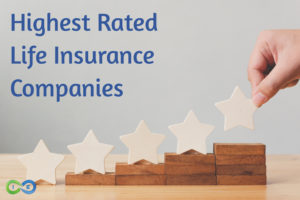Return of Premium Life Insurance, aka ROP insurance, aka ROP rider, has its place in the life insurance marketplace. In the following article we will discuss the pros and cons of return of premium life insurance, who should buy ROP insurance and why.
Return of Premium Term Life Insurance
In a previous article we extolled the many advantages of life insurance, specifically permanent life insurance coverage that builds cash value and lasts your entire life. We typically only recommend buying term if it is convertible. The one exception to this is return of premium term life insurance.
While initially cheaper than permanent life insurance (see our whole life insurance rates chart), term life insurance policies have some down side. While having the lowest out-of-pocket outlay of any type of individual life insurance policy, in order to reap a benefit from the policy, the insured must die while the policy is in force. Term premiums are inexpensively priced, because the insured is not expected to die during the term period.
Although it is not easy to substantiate, It is estimated that roughly 1% of term life insurance policies pay out.(1) The reason for such a low percentage of term insurance coverage actually paying out is either due to a policy lapse for non-payment of premiums, the policy is cancelled or the term expires.
Which is why another huge disadvantage of term life insurance is that, if the premium is not paid by the end of the 31-day grace period, the policy lapses. Thus, if the insured dies before the policy is reinstated, there is no death benefit.
Return of Premium (“ROP”) term life insurance is an option used by many of the top life insurance companies to solve these disadvantages. ROP term takes a basic term life insurance policy and adds a rider, for an additional premium, guaranteeing a 100% tax-free return of all money spent at the end of the term.
Depending upon the ROP life insurance company, guaranteed cash values start to accumulate following the first 4 to 6 years following the term policy’s issuance.
For example, under a typical 30-year ROP term policy, the cash available to the insured would approximate 50% of the premiums paid by the end of the 20th year and 100% of the premiums paid by the 30th year.
Top 5 Best Benefits of Return of Premium Life Insurance
Death Benefit
As with all life insurance coverage, if you die while the policy is in force your beneficiary receives a death benefit payout.
Return of Premium
If you live to the end of the ROP term life policy, you can choose two options. You can either receive a return of all your premiums paid income tax free or you can use the cash value that has accumulated to purchase paid-up life insurance.
Automatic Premium Loan
With some life insurance carriers, if a premium is not paid by the 31-day grace period, an automatic premium loan will be made – assuming sufficient cash value exists in the policy. This automatic loan avoids a lapse of the policy, keeping 100% of the death benefit in force.
Reduced Paid-Up
Other insurance providers apply the cash values to buy reduced paid-up insurance to age 95, if a payment is missed. Obviously, such features are not available with basic term insurance, which has no cash value.
Convertible
The availability to convert an ROP term policy into a permanent policy, without having to go through life insurance underwriting, is available. In the event of a conversion, cash values accumulated in the ROP policy can be applied to the new permanent policy.
Return of Premium Life Insurance Quotes
The following term life insurance with return of premium rider quotes are for informational purposes only are not a guarantee of what your actual ROP premium payments will be. All ROP term policies must be qualified for.
$250,000
By way of comparison, a 35-year-old male, preferred plus underwriting risk, can buy a 30-year term policy with $250,000 death benefit at an annual premium of $260. If he outlives the term, he would have spent $7,800 in premiums and received nothing in return.
Alternatively, this same individual could purchase a 30-year ROP policy with $250,000 death benefit at an annual premium of $550. If he outlived the term of the ROP policy, he would be entitled to a return of $16,500 or a guaranteed paid-up policy worth $33,250.
$500,000
Further, that same 35-year-old male, preferred plus underwriting risk, can buy a 30-year term policy with $500,000 death benefit at an annual premium of $440. If he outlives the term, he would have spent $13,200 in premiums and received nothing in return.
Alternatively, this same individual could purchase a 30-year ROP policy with $500,000 death benefit at an annual premium of $945. If he outlived the term of the ROP policy, he would be entitled to a return of $28,350 or a guaranteed paid-up policy worth $57,500.
$1,000,000
One last example, that same 35-year-old male, preferred plus underwriting risk, can buy a 30-year term policy with $1,000,000 death benefit at an annual premium of $775. If he outlives the term, he would have spent $23,250 in premiums and received nothing in return.
Alternatively, this same individual could purchase a 30-year ROP policy with $1,00,000 death benefit at an annual premium of $1,900. If he outlived the term of the ROP policy, he would be entitled to a return of $57,000 or a guaranteed paid-up policy worth $115,000.
In addition to allaying the concerns regarding the disadvantages of term insurance, an ROP policy can also provide the advantage of supplementing retirement benefits to the policy owner/insured at the end of the term period.
These same individuals seeking to enhance their retirement benefits may also have concerns about the seemingly imminent substantial reduction in Social Security payments years from now. ROP term is especially attractive to policyholders who do not possess the wherewithal or the desire to pay whole life insurance premiums.
From a business planning viewpoint, ROP policies are useful for funding key-person insurance and buy-sell agreements. ROP policies offer the ability to recapture the insurance cost, tax free, either to supplement deferred compensation for the insured’s employees or to assist in the funding of a lifetime buy-out.
For further question, please don’t hesitate to reach out to Insurance and Estates for a free strategy session.
Article written in part by
Eric S. Ratliff, JD, LLM
Ratliff Law Firm
740 Pollard Road
Kodak, TN 37764
(865) 932-3441 x704
eratliff@ratlifflawfirm.com





